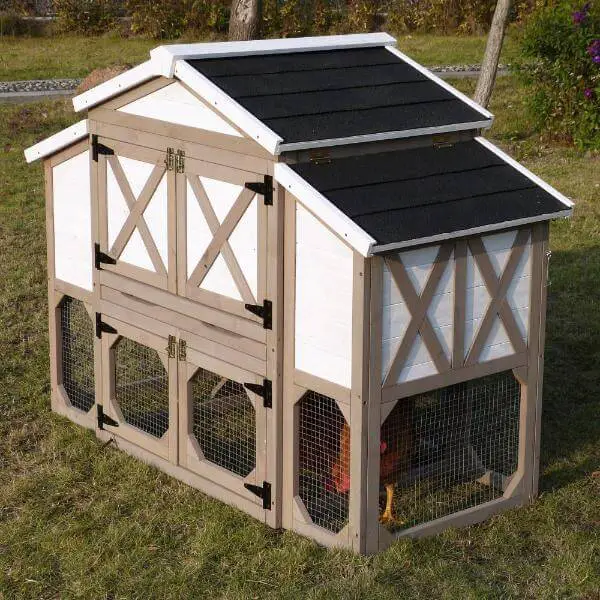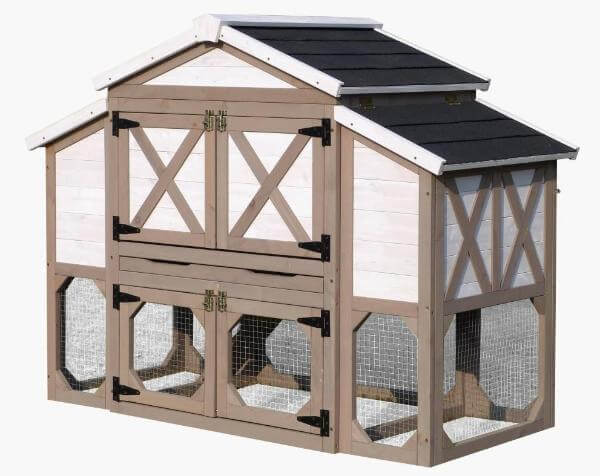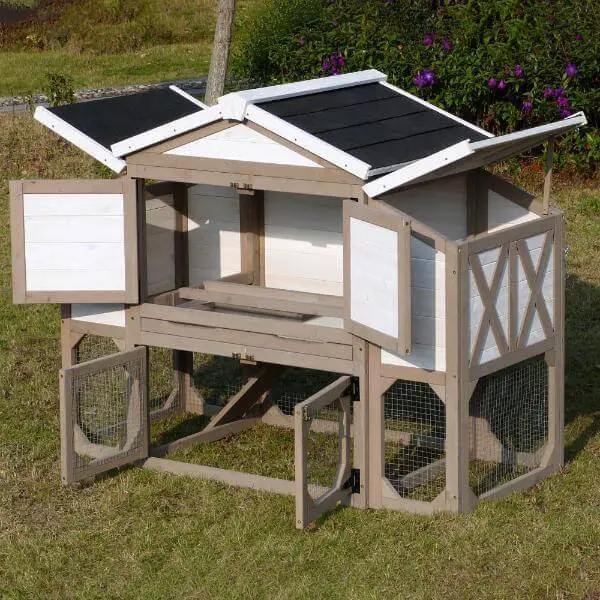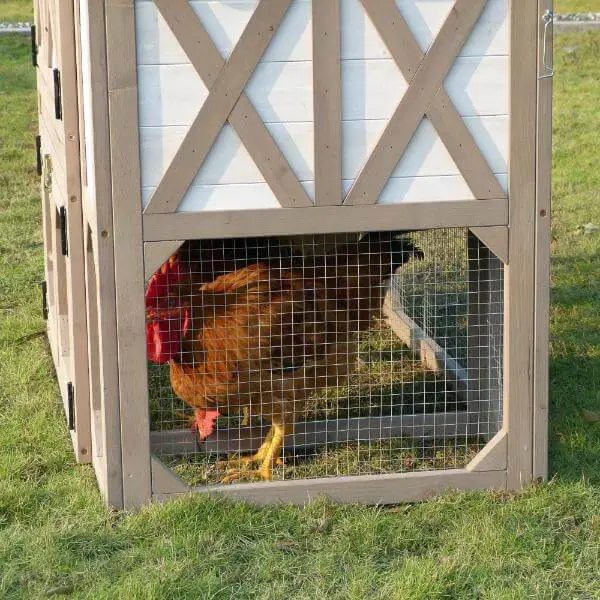This is the poultry hutch that provides the sturdy, secure shelter needed for raising free range chickens in one’s backyard. The spacious, pre-painted wood hutch and lower run ensure a happy, healthy brood of egg layers.

The bi-level hutch’s two nesting boxes are accessed from hinged doors, making it easy to collect farm fresh eggs and providing ventilation to keep your birds cool.

Made from Canadian Hemlock, the unit is finished with black asphalt shingles and has a removable tray for easy cleaning.

An over 4′ long wire enclosure beneath the hutch gives chickens room to roam, prevents break-ins from predators, and has a pair of lockable doors.

Recommended for up to four chickens (not included). Please check local ordinances to confirm raising chickens is permitted in your city.
Assembly required. 40 1/2″ H x 26″ W x 52 3/4″ L. (61 lbs.) ($25)
In recent years, the desire for sustainable living and the benefits of home-grown produce have led many urban and suburban dwellers to explore backyard chicken keeping.
However, one of the challenges faced by those with limited outdoor space is designing a functional and efficient chicken coop. A well-designed chicken coop can maximize space utilization while ensuring the health and comfort of your feathered friends.
Let’s explore the key considerations and strategies for creating a chicken coop tailored to small backyard settings.
- Planning and Design: Before diving into construction, careful planning is essential. Assess the available space in your backyard and consider factors such as local regulations, sunlight exposure, and proximity to neighbors. Sketch out a rough design, taking into account the number of chickens you plan to keep and any additional features you desire, such as nesting boxes, perches, and an attached run.
- Size and Scale: While space may be limited, it’s crucial to provide adequate room for your chickens to roam and roost comfortably. A general rule of thumb is to allow at least 2-3 square feet of indoor space per chicken, with an additional 4-5 square feet of outdoor space in a run or fenced area. For small backyard coops, vertical space can be optimized with multi-level designs or tiered roosting platforms, allowing chickens to utilize vertical space efficiently.
- Mobility and Accessibility: In a small backyard, versatility is key. Consider incorporating features that allow for easy mobility and access to the coop. For example, wheels or a lightweight frame can facilitate moving the coop to different areas of the yard, providing fresh foraging opportunities and minimizing wear on the grass. Additionally, ensure that the coop is accessible for cleaning and egg collection, with removable panels or hinged doors for convenient maintenance.
- Climate Control: Proper ventilation and insulation are essential for regulating temperature and humidity levels within the coop, especially in regions with extreme weather conditions. Windows or vents can be strategically placed to encourage airflow, while insulation materials such as foam board or reflective insulation can help retain heat in colder months. Shade structures or awnings can also provide relief from direct sunlight during hot summer days.
- Nesting and Roosting: Chickens have natural instincts to roost and lay eggs in secluded, elevated spaces. Incorporating nesting boxes with ample bedding material provides a cozy environment for egg-laying, while elevated roosting bars simulate natural perching behavior. In a small coop, compact nesting boxes can be mounted along the walls, utilizing vertical space efficiently. Position roosting bars higher than the nesting boxes to discourage chickens from sleeping in the nesting areas.
- Security and Predation Prevention: Protecting your flock from predators is paramount, regardless of the coop’s size. Secure the coop with sturdy fencing or hardware cloth to deter burrowing animals and opportunistic predators. Ensure that doors and openings are equipped with predator-proof latches or locks, and consider adding motion-activated lights or alarms for added security during nighttime hours.
- Integration with the Landscape: Aesthetics play a role in small backyard design, and integrating the chicken coop seamlessly into the landscape can enhance the overall appeal of your outdoor space. Choose materials and finishes that complement existing structures and landscaping elements, such as matching paint colors or natural wood accents. Incorporating climbing plants or greenery around the coop can also soften its appearance and provide additional shade and foraging opportunities for your chickens.
- Sustainable Practices: Embrace sustainable practices in your chicken keeping endeavors by incorporating eco-friendly features into the coop design. Collecting rainwater from the coop roof for watering plants or installing a composting system for chicken waste are just a few ways to minimize environmental impact and create a self-sustaining backyard ecosystem.
Designing a chicken coop for a small backyard requires careful planning, creativity, and attention to detail. By maximizing space utilization, prioritizing mobility and accessibility, and incorporating features for climate control, security, and sustainability, you can create a functional and aesthetically pleasing environment for your feathered companions. With the right design and management practices, even the smallest of backyards can become a thriving oasis for urban chicken keeping enthusiasts.